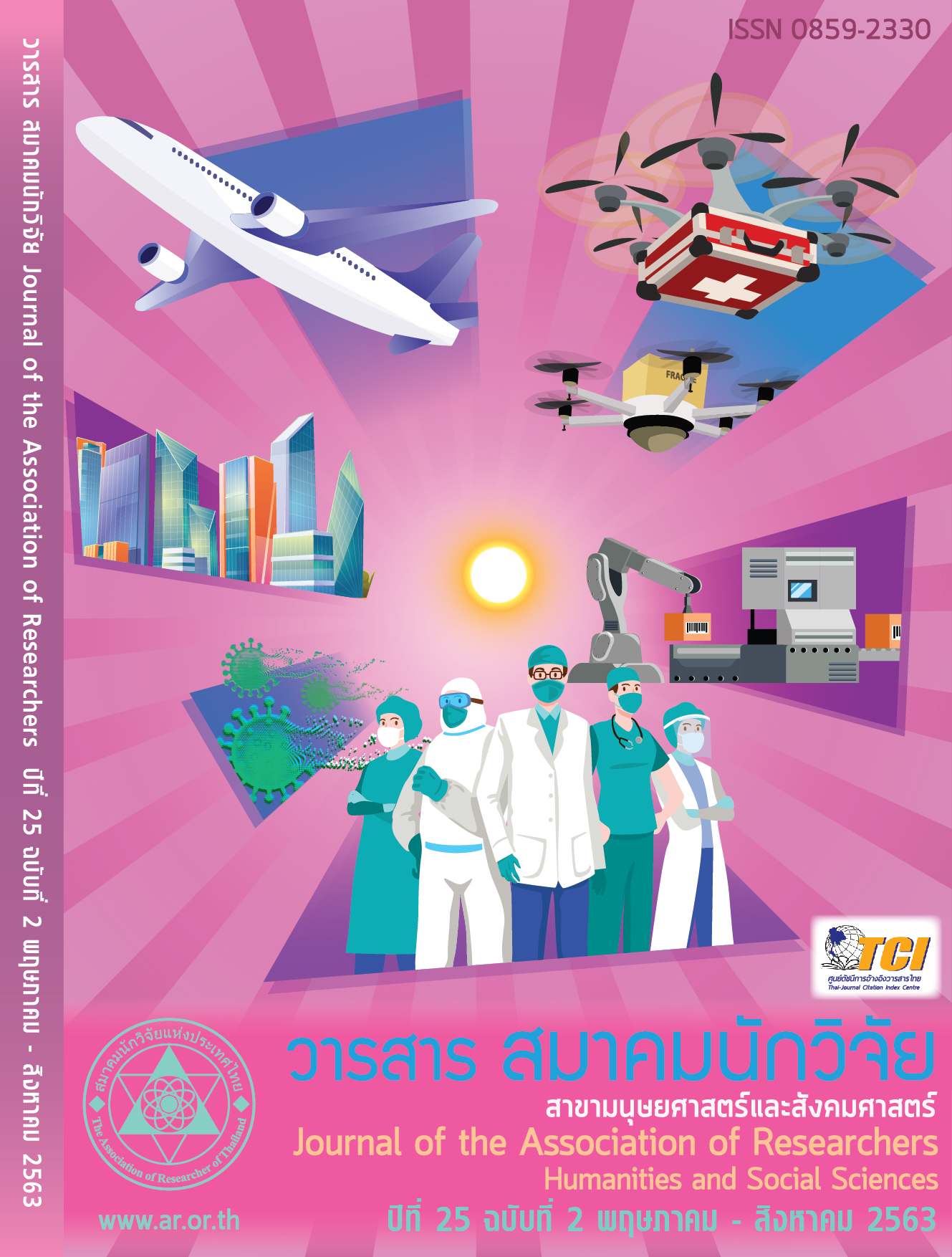Japanese Service Components Affecting Customer-based Brand Equity: The Mediating Role of Customer Satisfaction (A Case of Thai Consumers)
Main Article Content
Abstract
Japan has become world-famous for its customer service. However, customers in different cultures may have dissimilar perceptions of service quality. This study aims to investigate the Japanese service components and determine its empirical effects on brand equity which mediate by customer satisfaction.
Qualitative data were collected through in-depth interviews with 20 Japanese for exploring Japanese service components and developing the questionnaire. Data was collected from 434 Japanese respondents for confirming Japanese service components by using exploratory and confirmatory factor analysis. The finding indicated that Japanese service components consist of system, technology, staff ability, staff spirit, and place. Data was collected from 400 Thai respondents for investigating Japanese service components affecting brand equity which mediate by customer satisfaction by using path analysis. The finding indicated that staff ability, staff spirit, and place have an effect on brand equity through customer satisfaction, but system and technology have no effect on brand equity.
Article Details
บทความที่ปรากฏในวารสารนี้ เป็นความรับผิดชอบของผู้เขียน ซึ่งสมาคมนักวิจัยไม่จำเป็นต้องเห็นด้วยเสมอไป การนำเสนอผลงานวิจัยและบทความในวารสารนี้ไปเผยแพร่สามารถกระทำได้ โดยระบุแหล่งอ้างอิงจาก "วารสารสมาคมนักวิจัย"
References
Al-alsheikh, A. (2014). The origin of Japanese excellent customer service. Studies in Business and Accounting, 8, 23-42.
Anderson, J. C. & Gerbing, D. W. (1988). “Structural equation modeling in practice: a review and recommended two-step approach,” Psychological Bulletin, 103, 411-423.
Clements, J. (2018). An armchair travelers' history of Tokyo. London, England: BookHaus Cornell University (n.d.). Fit statistics commonly reported for CFA and SEM. Retrieved from https://www.cscu.cornell.edu/news/Handouts/SEM_fit.pdf
Cronbach, L. J. (1990). Essentials of psychological testing (5th ed.). New York, NY: Harper Collins.
De Mente, B. L. (2004). Japan's cultural code words. Vermont, VT: Tuttle.
DePaulo, P. (2000). The sample size for qualitative research. Retrieved from http://www.quirks.com/articles/a2000/20001202.aspx?searchID=38577919
Fornell, C., & Larcker, D. (1981). Evaluating structural equation models with unobserved variable and measurement error. Journal of Marketing Research, 18, 39-50.
Hair, Joseph F., Anderson, Rolph E., Tatham, Ronald L and Black, William C. (1998). Multivariate data analysis (5th ed.) New York, NY: MacMillan.
Harrington, D. (2009). Confirmatory factor analysis. New York, NY: Oxford.
Herbig, P. (1995). Marketing Japanese style. London, England: Quorum books.
Hood, C. P. (2015). Japan the basics. New York, NY: Routledge.
Ikeda, N. (2013). Omotenashi: Japanese hospitality as the global standard. In Monden, Y., Imai, N., Matsuo, T., & Yamaguchi, N. (Eds.), Management of service business in Japan (pp. 145-154). New Jersey, NJ: World Scientific.
Inkster, I. (2000). Culture and technology in Japan. In Inkster, I., & Satofuka, F. (Eds.). Japan in culture and technology in modern Japan (pp. 1-22). London, England: I.B. Tauris.
Karan, P. P. (2005). Japan in the 21st Century: Environment, economy, and society. Kentucky, KY: University Press of Kentucky.
Kempton, B. (2018). Wabi-sabi: Japanese wisdom for a perfectly imperfect life. London, England: Piatkus.
Kennedy, E. (1994). Destination Japan: A business guide for the 90s. Pennsylvania, PA: Diane.
Kirk, S. (2002). Japan gave me some good ideas. Japan Close-up, 7(12), 11.
Majid, E., Zahra, M., & Azade, R. (2016). Effect of dimensions of service quality on brand equity in the fast-food industry. Studies in Business, 11(3), 30-46. https://doi.org/10.1515/sbe-2016-0033
Ministry of Economic Trade and Industry. (2016). Hospitality standard certification 2019. Retrieved from https://www.service-design.jp/murasaki/
Morgan, J. C., & Morgan, J. J. (2007). Cracking the Japanese market. New York, NY: Free Press
Nagasaka, Y., & Lee, G. (2013). Application of information and communication technology. In Monden, Y., Imai, N., Matsuo, T., & Yamaguchi, N. (Eds.), Management of service business in Japan (pp. 167-181). New Jersey, NJ: World Scientific.
Nordic Council of Ministers. (2005). The Nordic model of consumer and customer satisfaction. Copenhagen, Denmark: Norden.
Nute, K. (2004). Place, time, and being in Japanese architecture. New York, NY: Routledge.
Ong, K. S., Nguyen, B., & Alwi, S. F. S. (2017). Consumer-based virtual brand personality (CBVBP), customer satisfaction, and brand loyalty in the online banking industry. International Journal of Bank Marketing, 35(3), 370-390, https://doi.org/10.1108/IJBM-04-2016-0054
Parasuraman, A., Zeithaml, V. A., & Berry, L. L. (1988). SERVQUAL: A multiple-item scale for measuring consumer perception of service quality. Journal of Retailing, 64(1), 12-40.
Richie, J., Lewis, J., & Elam, Gillian. (2003). Designing and selecting samples. In Ritchie, J., & Lewis, J. (Eds.), Qualitative Research Practice: A Guide for Social Science Students and Researchers. (pp. 77-108). London, England: Sage.
Sharma, V. (2017). Patient satisfaction and brand loyalty in health-care organizations in India.Journal of Asia Business Studies, 11(1), 73-87, https://doi.org/10.1108/JABS-09-2015-0157
Sonoda, T. (2013). The service level agreements at Japanese companies and their expansion. In Monden, Y., Imai, N., Matsuo, T., & Yamaguchi, N. (Eds.), Management of service business in Japan (pp. 155-165). New Jersey, NJ: World Scientific.
Verma, H. (2009). Service marketing text and cases. New Delhi, India: Pearson.
Wirtz, J. & Lovelock, C. (2016). Service marketing (8th ed.). New Jersey, NJ: World Scientific.
Yi, Z. (2016). Introducing omotenashi to the world: challenges to Japanese customer service in a cross-cultural setting. Transcultural Management Review, 13, 47-63.
Zavattaro, S. (2014). Place branding through phases of the image. New York, NY: Palgrave Macmillan.


